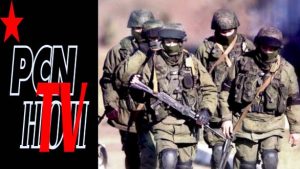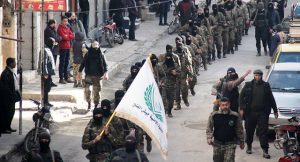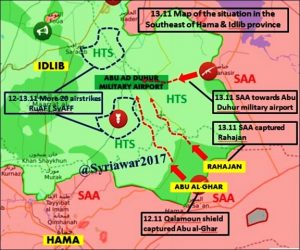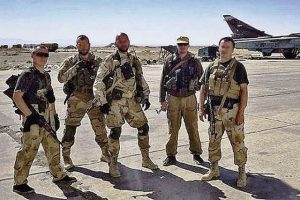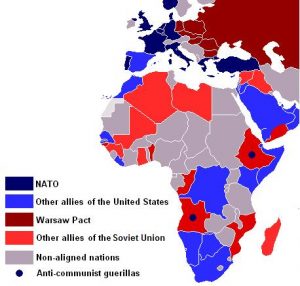LUC MICHEL (ЛЮК МИШЕЛЬ) & EODE/
Luc MICHEL pour EODE/
Quotidien géopolitique – Geopolitical Daily/
2018 01 16/
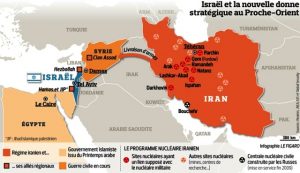
Un mot tout d’abord à mes lecteurs :
Plusieurs d’entre vous me demandent pourquoi je consacre tant de place à la guerre de Syrie. La Syrie – qui passe en ce moment d’une guerre civile internationalisée à une seconde guerre entre les blocs géopolitiques – est l’épicentre de la « nouvelle Guerre froide 2.0 », celles où le Bloc américano-occidental est directement face au Bloc de Shanghai (Moscou, Pékin, Téhéran). Ce qui se passe en Syrie a et aura des conséquences géopolitiques directes, régionales et mondiales. Il y a notamment une diagonale stratégique Sébastopol-Tartous, vitale pour la Russie … depuis Catherine la Grande (l’Est ukrainien étant le deuxième point chaud de la Guerre froide 2.0, où les USA préparent en ce moment une nouvelle confrontation avec les russes). Il y a une seconde diagonale stratégique, celle qui va de l’iran au Liban (« l’Axe de la résistance ») et a des projections vers le Golfe, la Mer rouge et le Yémen. La Syrie est donc le dossier (ou le front) central de la géopolitique actuelle …
I- LE HEZBOLLAH ET L’ARMEE ARABE SYRIENNE : LES CRAINTES D’ISRAEL
Le journal panarabe ‘Rai al-Youm’, cité par l’agence de presse ‘Mizan’, rapporte ce 11 janvier que « les frappes aériennes de l’aviation israélienne en Syrie ciblaient les convois d’armes destinés au Hezbollah, mouvement qui suscite la peur et la hantise cauchemardesque du régime de Tel-Aviv ».
Les autorités militaires israéliennes redoutent une montée en puissance de l’armée syrienne et du Hezbollah, d’où les frappes aériennes dévastatrices contre la ville de Quneitra, sur le Golan syrien, dans la banlieue profonde de Damas. Le cabinet de Benyamin Netanyahu n’a pas reconnu officiellement la responsabilité de ces raids. Par contre, il a publié un communiqué affirmant « sa détermination à prendre toutes les mesures nécessaires pour empêcher tout transfert d’armes au Hezbollah via le territoire syrien ».
Le cauchemar d’Israël ce sont en effet les armes sophistiquées du Hezbollah ! La vraie obsession des Israéliens est que le Hezbollah accède à des armes avancées et prenne le dessus. L’arsenal du mouvement est musclé : « outre des missiles balistiques, il comporte des navires de guerre furtifs, indétectables par les radars, et des sous-marins capables de cibler les ressources gazières du régime israélien, tous construits dans les bases du Hezbollah au Liban ».
L’INANITE DES MENACES DE NETANYAHU CONTRE LE HEZBOLLAH
Le Premier ministre israélien profère des menaces et n’a recours qu’aux frappes aériennes, lesquelles n’ont pas pu faire avancer ses ambitions. Il a dernièrement menacé de « contrecarrer le déploiement des forces de l’armée syrienne et des unités du Hezbollah sur les frontières de l’Est, au sud de la Syrie ». Néanmoins, l’armée syrienne domine fortement la Ghouta occidentale (banlieue de Damas) et a atteint Quneitra et les frontières du Golan occupé.
LES DERNIERS JOURS DE LA GUERRE EN SYRIE
Le triangle composé de la Syrie, de l’Iran et du Liban représente encore la principale menace pour Israel. Surtout que la guerre en Syrie touche à sa fin et que l’Axe de la Résistance, soutenu par Moscou et Pékin, accumule les victoires aussi bien en Syrie qu’en Irak (1).
L’HOSTILITE FONDAMENTALE DES USA ET D’ISRAËL CONTRE LA SYRIE
Les frappes israéliennes en Syrie sous prétexte « d’anéantir les convois d’armes destinés au Hezbollah », et ce, dans une conjoncture où les pays arabes du golfe Persique font des pieds et des mains pour normaliser leurs relations avec Tel-Aviv, montrent bien que la « boussole » syrienne n’a pas changé de direction et pointe toujours vers son véritable ennemi.
LES MISES EN GARDE DU HEZBOLLAH
Le secrétaire général du Hezbollah Hassan Nasrallah a, lors d’une interview accordée le mercredi 10 janvier à la chaîne libanaise ‘Al-Mayadeen’, révélé que « l’Axe de la Résistance se prépare pour une guerre majeure contre Israël » et que « Trump a placé la région face à l’alternative suivante : soit accepter les diktats américains, soit subir une guerre ». « Notre projet n’est pas celui de la guerre mais de la résistance. Trump et Netanyahu pourraient entraîner la région dans une guerre. Les forces de la résistance doivent se préparer à une éventuelle guerre », a-t-il dit.
ISRAËL, LE GRAND PERDANT DE LA GUERRE
Le gouvernement de Damas et le Hezbollah savent que ceux qui sabotent le processus de paix via la décision de l’Administration Trump sur la modification du statut de Jérusalem cherchent en effet la guerre. « Mais cette guerre, tout comme les complots fomentés au cours de ces sept dernières années, échouera et le grand perdant en sera le régime d’Israël. La donne a changé et la force aérienne n’est plus un atout comme par le passé », conclut ‘Rai al-Youm’.
II- LES CHANGEMENTS POROFONDS DU CONTEXTE INTERNATIONAL
Le contexte international qui influe sur Israël s’est profondément modifié au cours de cette dernière année de la Guerre syrienne, dans deux directions essentielles. Tout d’abord, Moscou est sortie de sa neutralité bienveillante de jadis envers Tel-Aviv (2). Deuxièmement, dans le cadre du nouvel Axe Washington – Riyad – Tel-Aviv mis en place par Trump et le Likoud (3), Israël s’est rapproché publiquement des monarchies du Golfe, levant le grand tabou occulté du Proche-Orient : l’alliance stratégique entre Israël et les régimes conservateurs arabes.
MOSCOU CONDAMNE LA COLONISATION ISRAELIENNE EN PALESTINE
Signe des nouvelles relations entre Moscou et Tel-Aviv, qui se sont rapidement dégradées depuis quelques mois. Moscou vient de déclarer que « la colonisation enraye les négociations israélo-palestiniennes » … Au moment où « un feu vert a été donné à plus de 1 100 nouveaux logements de colons en Cisjordanie, territoire palestinien occupé par l’armée israélienne ».
Moscou réagit donc sèchement à la poursuite de la colonisation des territoires palestiniens en Cisjordanie par Israël. Le Ministère russe des Affaires étrangères estime que « la colonisation israélienne ne contribue pas à la reprise des négociations directes entre les parties concernées ». « Moscou réaffirme sa position de principe sur l’illégalité des activités de colonisation israéliennes dans les territoires palestiniens, y compris à Qods-Est. Nous estimons que cette politique ne contribue pas à créer les conditions propices au lancement de négociations directes entre Israéliens et Palestiniens », lit-on sur le site du ministère. La poursuite de la colonisation par le régime israélien sape les perspectives de la « solution à deux États » au Proche-Orient et minimise la possibilité de parvenir à une paix « juste et durable » dans la région.
Rappelons que le 10 janvier, « Tel-Aviv a donné son feu vert à plus de 1 100 nouveaux logements de colons en Cisjordanie », a indiqué jeudi l’organisation anti-colonisation ‘la Paix maintenant’. « Les 1.122 unités d’habitation approuvées mercredi sont à différents stades dans la procédure : 352 ont reçu un feu vert final, ce qui signifie peu ou prou que les travaux peuvent commencer, alors que 770 autres ont été validées pour la première fois », rapporte aussi l’AFP.
La colonisation, autrement dit la construction d’habitations civiles dans les territoires palestiniens occupés ou annexés par Israël depuis 1967, est illégale au regard du Droit international.
GRANDES MANŒUVRES STRATEGIQUES ISRAELIENNES :
« NORMALISATION ECONOMIQUE MAJEURE ENTRE ISRAËL ET LE GOLFE » (AL MONITOR)
Derrière les projets économiques avec les régimes du Golfe, les israéliens visent avant tout des objectifs stratégiques …
Le 13 décembre, le ministre israélien du Renseignement et des Transports, Yisrael Katz, a annoncé « l’intention d’Israël de relancer le projet ferroviaire du Hejaz reliant le port israélien de Haïfa aux États du Golfe ». « Ce projet inquiète au plus haut point l’Egypte, car il pourrait se révéler être un concurrent au canal de Suez, avec à terme une baisse des revenus économiques de l’Egypte », commente la presse israélienne.
Un rappel historique :
Le chemin de fer du Hejaz a été construit en 1908 pour relier Damas à Médine en traversant la région de Hejaz en Arabie Saoudite. Il était censé s’étendre jusqu’à la Mecque, pour faciliter le pèlerinage dans la ville sainte. Une branche avait été ajoutée à ce chemin de fer qui allait jusqu’à Haïfa pour rejoindre la mer Méditerranée. On était là au cœur du « Grand Jeu » oriental (le premier du XIXe siècle), où le IIe Reich du kaiser Guillaume II faisait irruption dans la rivalité géopolitique entre Moscou et Londres. Mais quand la Première Guerre mondiale a éclaté, le chemin de fer et ses lignes annexes ont été partiellement détruites et les autres fermées.
Dans son interview avec ‘Elaph’ le 13 décembre 2017, le ministre Katz a expliqué quel était ce projet de « construction d’un chemin de fer qui serait parallèle à la côte de la mer Rouge et au canal de Suez ». « Nous allons prolonger la voie qui relie Haifa et Beit Shean au pont King Hussein; les Jordaniens l’étendront aussi de leur côté pour se relier aux chemins de fer saoudiens », a-t-il dit. Katz a souligné que « les études du projet sont achevées et que son concept et ses plans sont prêts. La construction devrait commencer dans un an ou deux après approbation par la Jordanie et les États du Golfe ». Il a confirmé que « ces pays avaient déjà la proposition du projet en main », mais n’a pas expliqué comment il leur avait été présenté.
« Il convient de noter que si le traité de paix israélo-jordanien régit les relations diplomatiques entre Israël et la Jordanie, l’Arabie saoudite n’a pas de relations diplomatiques avec Israël », rappelle la presse israélienne.
Dans l’interview, Katz a indiqué que « 25% des exportations de la Turquie vers le Golfe passent par le port de Haïfa et passent par la Jordanie ». Il a expliqué que « cette ligne de chemin de fer contribuera à réduire les frais de transport de l’Europe vers les pays du Golfe ».
Dans son émission télévisée du 18 décembre “Al-Tabaa al-Oula” sur ‘Dream TV’, l’ancien conseiller présidentiel aux médias Ahmed al-Meslemani a prévenu: « Ce chemin de fer sera une alternative au canal de Suez. Il affectera les revenus futurs du Canal d’autant plus qu’il sera plus sûr que le canal pour le cas où le conflit avec Yémen s’intensifierait et si les Houthis et la marine iranienne prenaient le contrôle du détroit de Bab al-Mandab ».
S’exprimant lors de la conférence « Calcalist 2018 sur les prévisions économiques », et qui a réuni de grands investisseurs et des hommes d’affaires le 25 décembre à Tel Aviv, Katz a décrit le chemin de fer du Hejaz comme « un projet historique ». « Je le pousse en avant. J’ai rencontré plusieurs fois des représentants et des organismes américains pour discuter de ce projet. Nous n’avons besoin que de 200 kilomètres pour relier les premiers rails de l’Arabie Saoudite à Israël via la Jordanie », a-t-il dit, ajoutant que « ce projet marquerait l’arrivée et le transit de la force économique de Riyad en Israël » !
LES CONSEQUENCES DE LA NORMALISATION ENTRE LES SAOUDS ET ISRAËL SUR L’ECONOMIE EGYPTIENNE
« Bien que l’impact direct du chemin de fer sur les revenus du canal de Suez puisse être discutable, ce projet de liaison terrestre entre Israël et l’Arabie Saoudite soulève des questions sur les conséquences de la normalisation entre le royaume saoudien et Israël sur l’économie égyptienne », commente la presse israélienne.
Un autre projet inquiète aussi l’Egypte. De nombreux experts et observateurs, dont l’ancien Premier ministre égyptien et candidat possible aux élections de 2018 Ahmed Shafiq et l’éminent journaliste égyptien Abdullah al-Sanawi, ont mis en garde « contre un accord potentiel entre Israël et l’Arabie Saoudite pour établir une alternative israélo-saoudienne au Canal de Suez, avec un canal alternatif reliant le port d’Eilat en Israël aux côtes israéliennes sur la mer Méditerranée ». Les navires empruntant ce canal passeraient par le détroit de Tiran, que l’Egypte a remis à l’Arabie Saoudite en vertu de l’accord de démarcation de la frontière maritime connu sous le nom d’ « Accord de Tiran et Sanafir ».
Kamal Amer, le président du Comité de la défense nationale et de la sécurité du Parlement égyptien, a déclaré à ‘al-Monitor’ : « En vertu de l’accord de Camp David, le détroit de Tiran est un cours d’eau international ouvert à toutes les nations. L’Egypte ne peut pas empêcher la navigation dans ce détroit pour le cas où Israël déciderait de creuser un canal reliant Eilat à la mer Méditerranée pour concurrencer le canal de Suez ». Il a poursuivi: « A ce jour Israël n’a pas encore été capable de mettre en œuvre un tel projet de canal, car son sol à cet endroit est très dur et il ne serait pas facile de creuser un couloir de navigation comme le canal de Suez. Mais s’il était construit l’Egypte ne pourrait pas entraver la navigation des navires qui souhaiteraient transiter par le canal israélien ».
« Pour l’heure, aucune alternative au canal de Suez ne devrait affecter les revenus du canal de sitôt ». Pourtant, la normalisation entre Israël et les pays du Golfe, en particulier l’Arabie saoudite, pourrait à un moment donné ou à un autre, « briser le monopole de Suez sur le commerce entre l’Est et l’Ouest ».
NOTES :
(1) Cfr. sur PCN-TV/ PRESSTV (IRAN) DEBAT AVEC LUC MICHEL:
L’ÉQUILIBRE DES FORCES AU MOYEN-ORIENT A CHANGÉ. VERS LA SECONDE GUERRE DE SYRIE
sur https://vimeo.com/250885505 Et :
Sur LUC MICHEL’S GEOPOLITICAL DAILY/
SYRIE D’UNE GUERRE A L’AUTRE (II): LA BATAILLE POUR IDLIB OU LE PASSAGE D’UN CONFLIT A L’AUTRE
sur http://www.lucmichel.net/2018/01/12/luc-michels-geopolitical-daily-syrie-dune-guerre-a-lautre-ii-la-bataille-pour-idlib-ou-le-passage-dun-conflit-a-lautre/
(2) Cfr. LUC MICHEL’S GEOPOLITICAL DAILY/ GRAND JEU AU PROCHE-ORIENT: POUTINE ‘NOUVEAU TSAR’ DE L’ORIENT (III). LA FIN DE LA NEUTRALITE BIENVEILLANTE AVEC ISRAEL
sur http://www.lucmichel.net/2017/12/20/luc-michels-geopolitical-daily-grand-jeu-au-proche-orient-poutine-nouveau-tsar-de-lorient-iii-la-fin-de-la-neutralite-bienveillante-avec-israel/
(3) Cfr. LUC MICHEL’S GEOPOLITICAL DAILY/ AXE WASHINGTON – RIYAD – TEL-AVIV : LA VIEILLE ALLIANCE HONTEUSE ENTRE SAOUDS ET ISRAELIENS NE SE DISSIMULE PLUS !
sur http://www.lucmichel.net/2017/11/17/luc-michels-geopolitical-daily-axe-washington-riyad-tel-aviv-la-vieille-alliance-honteuse-entre-saouds-et-israeliens-ne-se-dissimule-plus/
Et :
L’AXE WASHINGTON – RIYAD, LES REVIREMENTS DE TRUMP SUR LA POLITIQUE MOYEN-ORIENTALE DES USA ET LA VISION STRATEGIQUE DES ‘CINQ MERS’
sur http://www.lucmichel.net/2017/11/27/luc-michels-geopolitical-daily-laxe-washington-riyad-les-revirements-de-trump-sur-la-politique-moyen-orientale-des-usa-et-la-vision-strategique-des-cinq-mers/
Photo :
La capacité militaire du Hezbollah aurait septuplé depuis la deuxième guerre du régime israélien contre le Liban en 2006.
(Source : Rai al-Youm’ – Fars – al Monitor – EODE Think-Tank)
LUC MICHEL (ЛЮК МИШЕЛЬ) & EODE
* PAGE SPECIALE Luc MICHEL’s Geopolitical Daily https://www.facebook.com/LucMICHELgeopoliticalDaily/
________________
* Luc MICHEL (Люк МИШЕЛЬ) :
WEBSITE http://www.lucmichel.net/
PAGE OFFICIELLE III – GEOPOLITIQUE
https://www.facebook.com/Pcn.luc.Michel.3.Geopolitique/
TWITTER https://twitter.com/LucMichelPCN
* EODE :
EODE-TV https://vimeo.com/eodetv
WEBSITE http://www.eode.org/

